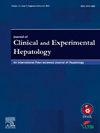活体供肝移植治疗小儿肝豆状核病相关急性肝衰竭-高回报的艰苦工作
IF 3.2
Q2 GASTROENTEROLOGY & HEPATOLOGY
Journal of Clinical and Experimental Hepatology
Pub Date : 2025-03-27
DOI:10.1016/j.jceh.2025.102560
引用次数: 0
摘要
肝移植(LT)适用于以急性肝衰竭(ALF)或慢性肝病(CLD)为表现的肝豆状核变性(WD)患儿。我们介绍了活体供肝移植(LDLT)治疗儿童WD的经验,讨论了处理WD- alf的挑战,并比较了WD- alf和WD- cld患儿的结果。方法比较WD-ALF和WD-CLD两组患者的临床表现和预后。53例儿童(WD- alf: 28例(53%),WD- cld: 25例(47%))接受了LDLT治疗。结果sd - alf组有较高的Kings New Wilson指数(KNWI)(15比9,P = 0.001),较高的小儿终末期肝病/终末期肝病模型评分(35比20,P = 0.001),更频繁的脑病(64%比4%,P = 0.001),持续溶血(86%比28%,<0.001)。术前机械通气、术中持续肾替代治疗(CRRT)、治疗性血浆置换(TPE)在WD-ALF患儿中分别占32%、46.5%和89%。WD-ALF患者术后ICU住院时间较长(4.5天vs 3天,P = 0.001),住院时间较长(20.5天vs 14天,P = 0.001),主要并发症较多(57% vs 20%, P = 0.006)。WD-ALF队列术后神经系统并发症(42.9% vs 8%, P = 0.004)和侵袭性真菌感染(21.4% vs无,P = 0.024)也较多。WD-ALF组围手术期(90 d)死亡2例,WD-CLD组无死亡。在26个月的中位随访中,整个队列的患者生存率为94.3%,所有幸存者都具有良好的同种异体移植物功能和神经后遗症。WD-ALF组患者生存率较低,但差异无统计学意义(88.5% vs 100%, log rank检验,P = 0.089)。结论ldlt治疗儿童WD具有良好的短期和长期疗效。WD-ALF患者术后病程复杂,但长期生存良好。本文章由计算机程序翻译,如有差异,请以英文原文为准。

Living Donor Liver Transplantation for Pediatric Wilson’s Disease-related Acute Liver Failure—Hard Work With High Rewards
Background
Liver transplantation (LT) is indicated for children with Wilson’s disease (WD) presenting with acute liver failure (ALF) or with chronic liver disease (CLD) that has progressed to decompensation. We present our experience of living donor liver transplantation (LDLT) for pediatric WD, discuss the challenges of managing WD-ALF and compare outcomes of children presenting with WD-ALF with WD-CLD.
Methods
We compared presentation and outcomes of the WD-ALF and WD-CLD cohorts. Fifty-three children (WD-ALF: 28 (53%), WD-CLD: 25 (47%)) underwent LDLT for WD.
Results
WD-ALF group had higher Kings New Wilson Index (KNWI) (15 vs 9, P = 0.001), higher pediatric end-stage liver disease/model for end-stage liver disease score (35 vs 20, P = 0.001), were more frequently encephalopathic (64% vs 4%, P = 0.001), and had ongoing hemolysis (86% vs 28%, <0.001). Preoperative mechanical ventilation, operative continuous renal replacement therapy (CRRT), therapeutic plasma exchange (TPE) was needed in 32%, 46.5%, and 89% of WD-ALF children, respectively. WD-ALF patients had longer postoperative ICU stay (4.5 days vs 3 days, P = 0.001), longer hospital stay (20.5 days vs 14 days, P = 0.001), more major complications (57% vs 20%, P = 0.006). WD-ALF cohort also had more postoperative neurological complications (42.9% vs 8%, P = 0.004) and invasive fungal infections (21.4% vs none, P = 0.024). There were two perioperative (90 day) mortalities in WD-ALF group and none in WD-CLD group. Patient survival of the entire cohort at median follow-up of 26 months was 94.3% and all survivors had good allograft function neurological sequelae. Patient survival was inferior for WD-ALF cohort though the difference was not statistically significant (88.5% vs 100%, log rank test, P = 0.089).
Conclusion
LDLT is a curative treatment for children with WD with excellent short-term and long-term outcomes. WD-ALF patients can have a complicated postoperative course but have good long-term survival.
求助全文
通过发布文献求助,成功后即可免费获取论文全文。
去求助
来源期刊

Journal of Clinical and Experimental Hepatology
GASTROENTEROLOGY & HEPATOLOGY-
CiteScore
4.90
自引率
16.70%
发文量
537
审稿时长
64 days
 求助内容:
求助内容: 应助结果提醒方式:
应助结果提醒方式:


